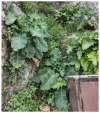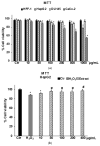Chemical, Antioxidant and Biological Studies of Brassica incana subsp. raimondoi (Brassicaceae) Leaf Extract
- PMID: 36770919
- PMCID: PMC9921728
- DOI: 10.3390/molecules28031254
Chemical, Antioxidant and Biological Studies of Brassica incana subsp. raimondoi (Brassicaceae) Leaf Extract
Abstract
Brassica incana subsp. raimondoi is an endemic taxon present in a restricted area located on steep limestone cliffs at an altitude of about 500 m a.s.l. in eastern Sicily. In this research, for the first time, studies on the phytochemical profile, the antioxidant properties in cell-free and cell-based systems, the cytotoxicity on normal and cancer cells by 3-(4,5-Dimethylthiazol-2-yl)-2,5-Diphenyltetrazolium Bromide (MTT) assay, and on Artemia salina Leach, were performed. The total phenolic, flavonoid, and condensed tannin contents of the leaf hydroalcoholic extract were spectrophotometrically determined. Ultra-performance liquid chromatography-tandem mass spectrometer (UPLC-MS/MS) analysis highlighted the presence of several phenolic acids, flavonoids, and carotenoids, while High-Performance Liquid Chromatography with Diode-Array Detection (HPLC-DAD) identified various kaempferol and isorhamnetin derivatives. The extract exhibited different antioxidant properties according to the five in vitro methods used. Cytotoxicity by MTT assay evidenced no impact on normal human fibroblasts (HFF-1) and prostate cancer cells (DU145), and cytotoxicity accompanied by necrotic cell death for colon cancer cells (CaCo-2) and hepatoma cells (HepG2), starting from 100 μg/mL and 500 μg/mL, respectively. No cytotoxic effects were detected by the A. salina lethality bioassay. In the H2O2-induced oxidative stress cell model, the extract counteracted cellular reactive oxygen species (ROS) production and preserved non-protein thiol groups (RSH) affected by H2O2 exposure in HepG2 cells. Results suggest the potential of B. incana subsp. raimondoi as a source of bioactive molecules.
Keywords: Artemia salina Leach; H2O2; HPLC/DAD; ROS; UPLC-MS/MS; botanicals; cabbages; carotenoids; nutraceuticals; oxidative stress; polyphenols.
Conflict of interest statement
The authors declare no conflict of interest.
Figures







References
-
- Maggioni L., Bothmer R., von Poulsen G., Branca F. Originband domestication of cole crops (Brassica oleracea L.): Linguistic and literary considerations. Econ. Bot. 2010;64:109–123. doi: 10.1007/s12231-010-9115-2. - DOI
-
- Branca F., Chiarenza G.L., Cavallaro C., Gu H., Zhao Z., Tribulato A. Diversity of Sicilian broccoli (Brassica oleracea var. italica) and cauliflower (Brassica oleracea var. botrytis) landraces and their distinctive bio-morphological, antioxidant, and genetic traits. Genet. Resour. Crop Evol. 2018;65:485–502. doi: 10.1007/s10722-017-0547-8. - DOI
-
- Ruggles Gates R. Wild cabbages and the effects of cultivation. J. Genet. 1953;51:363–372. doi: 10.1007/BF03023303. - DOI
-
- Malfa G.A., Acquaviva R., Bucchini A.A.E., Ragusa S., Raimondo F.M., Spadaro V. The Sicilian wild cabbages as biological resources: Taxonomic update and a review on chemical constituents and biological activities. Flora Mediterr. 2020;30:245–260.
MeSH terms
Substances
LinkOut - more resources
Full Text Sources
Medical

